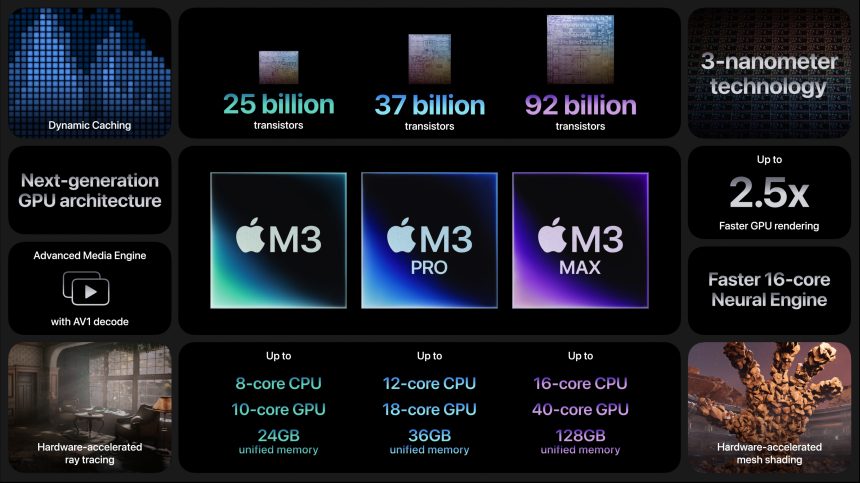Apple recently introduced three new MacBook Pro line-up laptops powered by the M3 Apple Silicon, aiming to capture the attention of consumers seeking an upgrade. Interestingly, the entry-level M3 MacBook Pro has been unveiled ahead of the anticipated MacBook Air with the same M3 chipset.
While the MacBook Air’s capabilities can be obtained from the smallest MacBook Pro, the difference in performance and potential within the M3 family may leave the MacBook Pro lacking the expected “Pro” qualities.
According to Mark Gurman from Bloomberg, Apple is actively developing an M3 Ultra processor, anticipated to feature in a new Mac Studio and potentially drive the Mac Pro in 2024, likely arriving in the second half of the year.
Looking ahead, the M4 family and Axx chipset series are expected to transition to a more efficient 2nm fabrication process. Apple’s strategic control over raw materials for 3nm chipsets suggests a potential leap to 2nm, with speculation that Tim Cook may have initiated orders to expedite the transition.
As Apple prepares to market the M3-powered MacBook Pro, potential buyers are urged to examine the offering carefully. Remember, Apple faced challenges in producing its iPhone and iPad modem despite acquiring Intel’s modem division in 2019.
While a modem is in the works for MacBooks, providing global cellular connectivity, it’s not expected until 2026, and MacBook users might not experience this feature until 2028 at the earliest.
Apple usually unveils a new MacBook Air with the introduction of a new Apple Silicon family. However, the M3 MacBook Pro took center stage with the recent launch, leaving MacBook Air enthusiasts waiting.
Examining the broader Apple ecosystem reveals a logistical decision, with the M3 chipset utilizing 3nm fabrication technology in high demand. Given the substantial sales volume of the iPhone 15 Pro and 15 Pro Max using the same technology, prioritizing iPhone production ensures a more abundant supply of 3nm materials.
The absence of a MacBook Air in the recent lineup aligns with Apple’s strategic prioritization of the iPhone. Launching the M3 MacBook Pro minimizes strain on the supply chain, allowing the iPhone to maintain its sales quantity during the crucial year-end quarter.
Apple unveiled a new MacBook Air in June, powered by the M2 chipset, making an October launch of a new MacBook Air less favorable to avoid presenting the M2 laptops as outdated just four months after their introduction.
Teardown specialists iFixit highlighted distinct features, such as a single fan, notable changes on the main circuit board, and a larger heat sink to enhance cooling efficiency.
Drawing parallels with previous MacBook hardware patterns, the M3 MacBook Pro mirrors the transitional design seen in the M1 and M2 MacBook Pros compared to their Air counterparts.
The unveiling of the M3 MacBook Pro may not have followed the expected pattern, but its unique features suggest a deliberate strategy. While the MacBook Air may not be available for purchase, the M3 MacBook Pro stands ready to cater to users seeking a balance between performance and the MacBook Pro status.
For now, we’ll have to wait until 2nd quarter of 2024 to find out what exactly the M3 MacBook Air has to offer.





